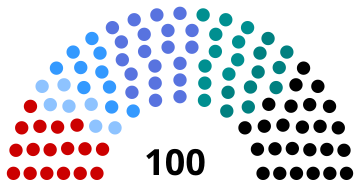1913 Dutch general election|
|
All 100 seats in the House of Representatives
51 seats needed for a majority |
| Turnout | 81.24% |
|---|
|
This lists parties that won seats. See the complete results below. ![]() Results by constituency |
|
General elections were held in the Netherlands on 17 June 1913,[1] with a second round in some constituencies on 25 June.[2] Despite receiving the fourth highest number of votes in the first round,[3] the General League of Roman Catholic Electoral Associations emerged as the largest party, winning 25 of the 100 seats in the House of Representatives.[4] After the election, the independent liberal Pieter Cort van der Linden became Prime Minister of the Netherlands, leading a cabinet of Liberals, Free-thinking Democrats, Christian Historicals and other independent liberals.
Results
 |
|---|
| Party | Votes | % | Seats | +/– |
|---|
| Anti-Revolutionary Party | 161,154 | 20.96 | 11 | –14 |
| Social Democratic Workers' Party | 142,273 | 18.51 | 16 | +9 |
| Liberal Union | 125,601 | 16.34 | 21 | +1 |
| General League | 122,969 | 16.00 | 25 | 0 |
| Christian Historical Union | 79,811 | 10.38 | 9 | –1 |
| Free-thinking Democratic League | 64,165 | 8.35 | 7 | –2 |
| League of Free Liberals | 48,731 | 6.34 | 10 | +6 |
| Independent Christian Historical | 5,664 | 0.74 | 1 | +1 |
| National League of Protestant Voters | 5,317 | 0.69 | 0 | 0 |
| Christian Social Party | 4,500 | 0.59 | 0 | 0 |
| Social Democratic Party | 1,339 | 0.17 | 0 | 0 |
| Christian Democratic Party | 1,220 | 0.16 | 0 | 0 |
| Independents | 6,008 | 0.78 | 0 | 0 |
| Total | 768,752 | 100.00 | 100 | 0 |
|
| Valid votes | 768,750 | 98.51 | |
|---|
| Invalid/blank votes | 11,621 | 1.49 | |
|---|
| Total votes | 780,371 | 100.00 | |
|---|
| Registered voters/turnout | 960,596 | 81.24 | |
|---|
| Source: Kiesraad, Huygens |
By district
Social Democratic
Free-thinking Democratic
Liberal
Free Liberal
Christian Historical
Anti-Revolutionary
Roman Catholic
Notes
- ^ Independent Christian historical.
- ^ Verheij died a month before the election.
References